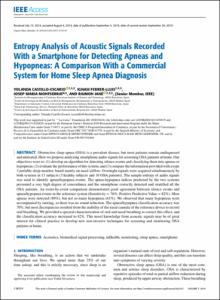Mostra el registre d'ítem simple
Entropy analysis of acoustic signals recorded with a smartphone for detecting apneas and hypopneas: A comparison with a commercial system for home sleep apnea diagnosis
| dc.contributor.author | Castillo Escario, Yolanda |
| dc.contributor.author | Ferrer Lluís, Ignasi |
| dc.contributor.author | Jané Campos, Raimon |
| dc.contributor.author | Montserrat Canal, Josep Maria |
| dc.contributor.other | Universitat Politècnica de Catalunya. Doctorat en Enginyeria Biomèdica |
| dc.contributor.other | Universitat Politècnica de Catalunya. Departament d'Enginyeria de Sistemes, Automàtica i Informàtica Industrial |
| dc.date.accessioned | 2020-03-11T11:30:31Z |
| dc.date.available | 2020-03-11T11:30:31Z |
| dc.date.issued | 2019-01-01 |
| dc.identifier.citation | Castillo-Escario, Y. [et al.]. Entropy analysis of acoustic signals recorded with a smartphone for detecting apneas and hypopneas: A comparison with a commercial system for home sleep apnea diagnosis. "IEEE access", 1 Gener 2019, vol. 7, p. 128224-128241. |
| dc.identifier.issn | 2169-3536 |
| dc.identifier.uri | http://hdl.handle.net/2117/179688 |
| dc.description.abstract | Obstructive sleep apnea (OSA) is a prevalent disease, but most patients remain undiagnosed and untreated. Here we propose analyzing smartphone audio signals for screening OSA patients at home. Our objectives were to: (1) develop an algorithm for detecting silence events and classifying them into apneas or hypopneas; (2) evaluate the performance of this system; and (3) compare the information provided with a type 3 portable sleep monitor, based mainly on nasal airflow. Overnight signals were acquired simultaneously by both systems in 13 subjects (3 healthy subjects and 10 OSA patients). The sample entropy of audio signals was used to identify apnea/hypopnea events. The apnea-hypopnea indices predicted by the two systems presented a very high degree of concordance and the smartphone correctly detected and stratified all the OSA patients. An event-by-event comparison demonstrated good agreement between silence events and apnea/hypopnea events in the reference system (Sensitivity = 76%, Positive Predictive Value = 82%). Most apneas were detected (89%), but not so many hypopneas (61%). We observed that many hypopneas were accompanied by snoring, so there was no sound reduction. The apnea/hypopnea classification accuracy was 70%, but most discrepancies resulted from the inability of the nasal cannula of the reference device to record oral breathing. We provided a spectral characterization of oral and nasal breathing to correct this effect, and the classification accuracy increased to 82%. This novel knowledge from acoustic signals may be of great interest for clinical practice to develop new non-invasive techniques for screening and monitoring OSA patients at home |
| dc.format.extent | 18 p. |
| dc.language.iso | eng |
| dc.publisher | Institute of Electrical and Electronics Engineers (IEEE) |
| dc.rights | Attribution-NonCommercial-NoDerivs 3.0 Spain |
| dc.rights.uri | http://creativecommons.org/licenses/by-nc-nd/3.0/es/ |
| dc.subject | Àrees temàtiques de la UPC::Informàtica::Automàtica i control |
| dc.subject.lcsh | Sleep apnea syndromes |
| dc.subject.lcsh | Signal processing |
| dc.subject.other | Acoustics |
| dc.subject.other | Biomedical signal processing |
| dc.subject.other | Health |
| dc.subject.other | monitoring |
| dc.subject.other | Sleep apnea |
| dc.subject.other | Smartphone |
| dc.title | Entropy analysis of acoustic signals recorded with a smartphone for detecting apneas and hypopneas: A comparison with a commercial system for home sleep apnea diagnosis |
| dc.type | Article |
| dc.subject.lemac | Síndromes d'apnea del son |
| dc.subject.lemac | Telèfons intel·ligents |
| dc.subject.lemac | Tractament del senyal |
| dc.contributor.group | Universitat Politècnica de Catalunya. BIOSPIN - Biomedical Signal Processing and Interpretation |
| dc.identifier.doi | 10.1109/ACCESS.2019.2939749 |
| dc.description.peerreviewed | Peer Reviewed |
| dc.relation.publisherversion | https://ieeexplore.ieee.org/document/8825772 |
| dc.rights.access | Open Access |
| local.identifier.drac | 25892423 |
| dc.description.version | Postprint (published version) |
| local.citation.author | Castillo-Escario, Y.; Ferrer, I.; Jane, R.; Montserrat, J. |
| local.citation.publicationName | IEEE access |
| local.citation.volume | 7 |
| local.citation.startingPage | 128224 |
| local.citation.endingPage | 128241 |
Fitxers d'aquest items
Aquest ítem apareix a les col·leccions següents
-
Articles de revista [1.397]
-
Articles de revista [39]
-
Articles de revista [105]


